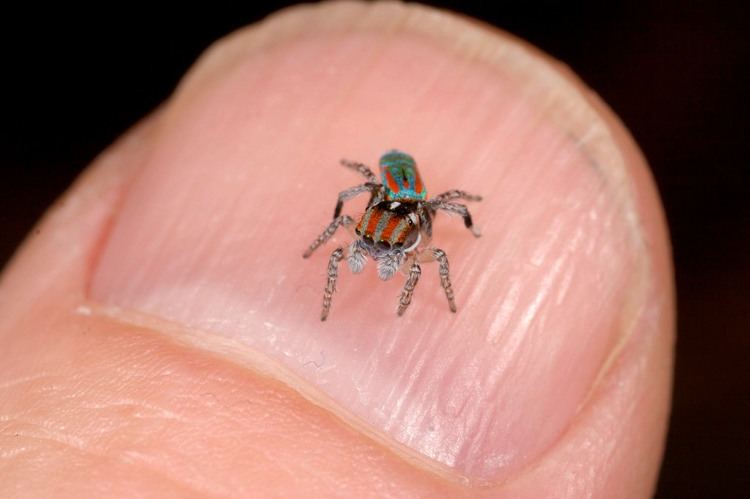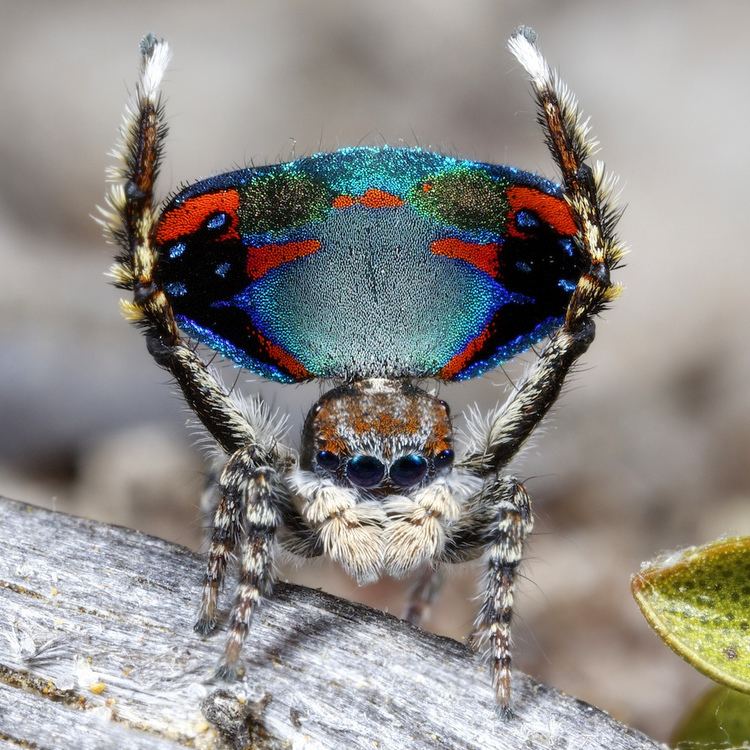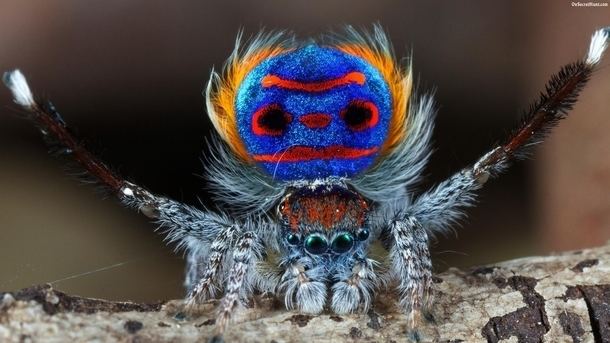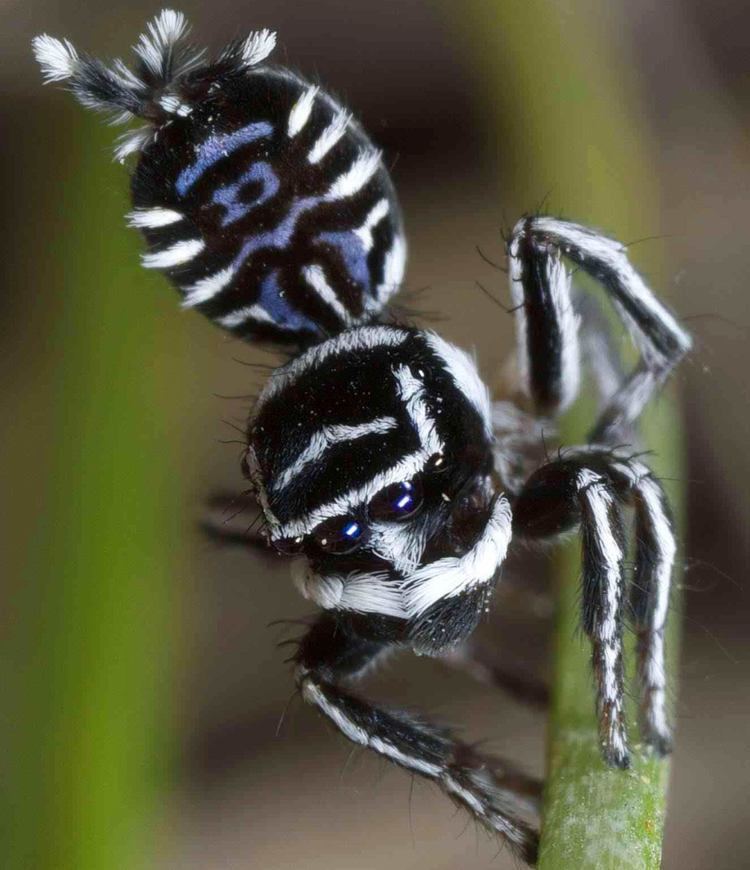Scientific name Maratus Rank Genus | Order Araneae Family Salticidae Higher classification Euophryinae | |
 | ||
Similar Peacock spider, Jumping spider, Coastal peacock spider, Arachnid, Maratus jactatus | ||
Peacock spider 7 maratus speciosus
Maratus is a spider genus of the family Salticidae (jumping spiders). These spiders are commonly referred to as peacock spiders due to the males' colorful and usually iridescent patterns on the upper surface of the abdomen often enhanced with lateral flaps or bristles, which they display during courtship. Females lack these bright colors, being cryptic in appearance. In at least one species, Maratus vespertilio, the expansion of the flaps also occurs during ritualised contests between males. The male display and courtship dance are complex, involving visual and vibratory signals.
Contents
- Peacock spider 7 maratus speciosus
- Peacock spider 16 maratus splendens
- Description
- Mechanisms utilised in colour production
- Taxonomy
- Phylogeny
- Species
- Names
- References

Several species in this genus were earlier classified in the genus Saitis, containing the Mediterranean Saitis barbipes, which is superficially similar to Maratus (colorful males with an enlarged third pair of legs). Saitis in Australia have enlarged and fringed third legs which they use for display but do not raise raise their abdomens like Maratus. All species of Maratus are found in Australia, with the exception of Maratus furvus from China. M. furvus was first described in 1992 in the genus Lycidas, becoming part of Maratus when Lycidas was synonymized in 2012. Otto and Hill consider this species cannot be linked to any genus with certainty.

Peacock spider 16 maratus splendens
Description

Maratus species are small spiders, with a total body length mostly around 4–5 mm (0.2 in), sometimes smaller, with a high degree of sexual dimorphism. They are known as Peacock Spiders, based on the peacock-like display of the dorsal (upper) surface of the abdomen (opisthosoma) of the males, on which there is a "plate" or "fan" of usually brightly colored and highly iridescent scales and hairs, often forming patterns in which the foreground colors contrast with the iridescent background. There may in addition be "flaps" or dense fringes of hairs at the sides of the abdomen, sometimes brightly colored. In both sexes, the abdomen is joined to the cephalothorax by a long and very flexible pedicel. This allows males to raise their abdomens, which may also be capable of being flattened and waved from side to side, thus emphasizing the appearance of the dorsal pattern. Not all species have colors that appear bright to human vision; Maratus vespertilio is relatively cryptically colored, with most iridescence on the lateral flaps. The abdominal display is used in courtship and, in at least one species, also in aggressive interactions with rival males. In almost all species, males have relatively long third legs, often brightly patterned, that are also used in courtship displays. Salticid spiders have excellent vision, with the ability to see in at least two colors: green and ultraviolet (UV). The male display includes vibratory signals in addition to visual ones. At least one species (Maratus fimbriatus) displays with its first pair of legs rather than its third pair. Some Maratus including Maratus calcitrans, Maratus digitatus and Maratus jactatus display with greatly enlarged and decorated spinnerets when their abdomen is elevated. One species from Cape Riche, Western Australia, in a region which is something of a hot-spot for Maratus species, does not utilise its abdomen in its display at all, instead using a combination of decorated third legs and its bright blue face and fluffy white pedipalps.

Male palpal bulbs are relatively simple in appearance, with a circular embolus, and are rather similar in different species. The palp usually has a simple retrolateral tibial apophysis with a blunt tip.

In contrast to the brightly coloured and distinctive males, females are cryptic or camouflaged in appearance, with mottled patterns of whitish and brownish scales. The epigyne is simple, with a pair of circular "windows" (fossae) to the front and a pair of oval spermathecae to the rear. The long and flexible pedicel allows females to rotate their abdomens by more than 180° during mating.
Mechanisms utilised in colour production

Male Maratus species mostly display to the females, in courtship dances, brilliantly coloured upper surface of their abdomen, often with extensions and fringes. Colours are produced by two main methods using scales (or modified hairs). One mechanism uses pigments to produce reds, whites, and creams in barbed scales that help scatter light. To produce blues the spiders utilise arrays of nanostructures reflecting light of particular wavelengths, in the case of Maratus splendens a shiny, sometimes violety blue. The nanostructures are embedded in flat, convex, sac-like scales, amplifying reflected light, according to University of Groningen’s Doekele Stavenga. This is the only animal where this kind of reflection has been shown. Stavenga compared Maratus colours with patterns on butterfly wings, the colors of flowers, and the feathers of the parotia bird. The blues produced by nanostructures in Maratus do not fade over time, unlike the normal pigmenting method. Other blue animals, like beetles, are rare but also utilise nanostructures. Nathan Morehouse of the University of Pittsburgh found Maratus volans have four different photoreceptors (tetrachromats) allowing them to see red, blue, green, and ultraviolet and also resolve the intracies of the male’s display designs.
Taxonomy
The genus Maratus was first described by Ferdinand Karsch in 1878. Karsch was a curator at the Museum für Naturkunde, Berlin, and named spiders and other animals from preserved specimens collected by others. He described the species Maratus amabilis, the type of his new genus, on the basis of a single male specimen, whose origin was only recorded as "Australia". His short description mentioned the abdomen being flattened and quadrangular in shape, but otherwise did not refer to the characteristic abdominal "flaps". In a footnote, he also named Maratus amoenus (now M. volans). Marek Żabka in 1987 was the first to restore Karsch's two species ofMaratus, moving more previously described species to the genus in 1991. Maratus was greatly expanded in the 21st century, both by known species being moved to Maratus and by the description of new species. Most of the new species have been described by Jürgen C. Otto and David E. Hill.
Otto and Hill suggest that Maratus is closely related to the genus Saitis. Both are found in Australia, and in both genera the males have elongated third legs and unmodified first legs.
Phylogeny
The relationships among Maratus and related genera are unclear, and many species await description. Otto and Hill synonymized Lycidas with Maratus) in 2012 recognising the type species for Lycidas, Lycidas anomalus was actually a Maratus, thus causing all then named Lycidas to be subsumed by Maratus. They hypothesize that the remaining genera may be related as shown below:
One molecular phylogenetic study, by Junxia Zhang in 2012, concluded that the seven Australian genera Hypoblemum, Jotus, Lycidas, Maileus, Maratus, Saitis and Prostheclina were so closely related that they could all be accommodated in Saitis but this suggestion has not been carried through to any taxonomic publication. In the Saitis group, the third leg is longer and the first leg unspecialized. In the Jotus group the first leg is longer and specialized. In both Maratus and some Hypoblemum in the Maratus group, the abdomen is raised during courtship, but only Maratus has a colorful dorsal plate.
Species
See World Spider Catalog, Otto & Hill 2014 2016 Baehr & Whyte 2016
Names
Early scientific names mostly used Latin or Greek descriptors, for example the type species Maratus amabilis (1878) referies to the friendly or pleasant Maratus. Maratus volans (1874) means the flying Maratus, reflecting the mistaken belief this species (and indeed the genus) could fly by means if its extended abdominal flap. We now know they cannot fly and the flap is used in courtship or (in at least one case) ritualised combat. Maratus chrysomelas refers to the golden yellow iridescence of the abdomen when viewed at some angles. In 1947 Dunn used the species name pavonis meaning peacock. Zabka and Waldock continued the tradition of using Latin and Greek in the 1980s and 1990s as did Otto & Hill from 2011 on, also using a patronym for Stuart Harris in the case of Maratus harrisi. As Peacock Spiders became more popular, so did patronyms, with Maratus purcellae for its discoverer Otto & Hill 2013 and Maratus proszynski for Jerzy Prószyński Waldock 2015. Common names featured in news media gained traction, particularly with Sparklemuffin for Maratus jactatus. In July 2016, Barbara Baehr and Robert Whyte from the Queensland Museum announced a newly discovered species to be named Maratus licunxin or Maratus licunxini after the artistic director of the Queensland Ballet, Li Cunxin and honoured Jürgen Otto with Maratus ottoi, Michel Duncan and Michael Doe with Maratus michaelorum, and Julianne Waldock with Maratus julianneae.
Maratus splendens and Maratus rainbowi refer to the same, single species, both listed here. Otto & Hill, when describing the female for the first time chose to continue to use Rainbow's Maratus splendens rather than Roewer's replacement name Maratus rainbowi. While Maratus rainbowi still appears in a number of on-line catalogs, all published descriptions and studies of this spider to date have used the original name Maratus splendens, the replacement name never having gained currency, and no longer preoccupied.
